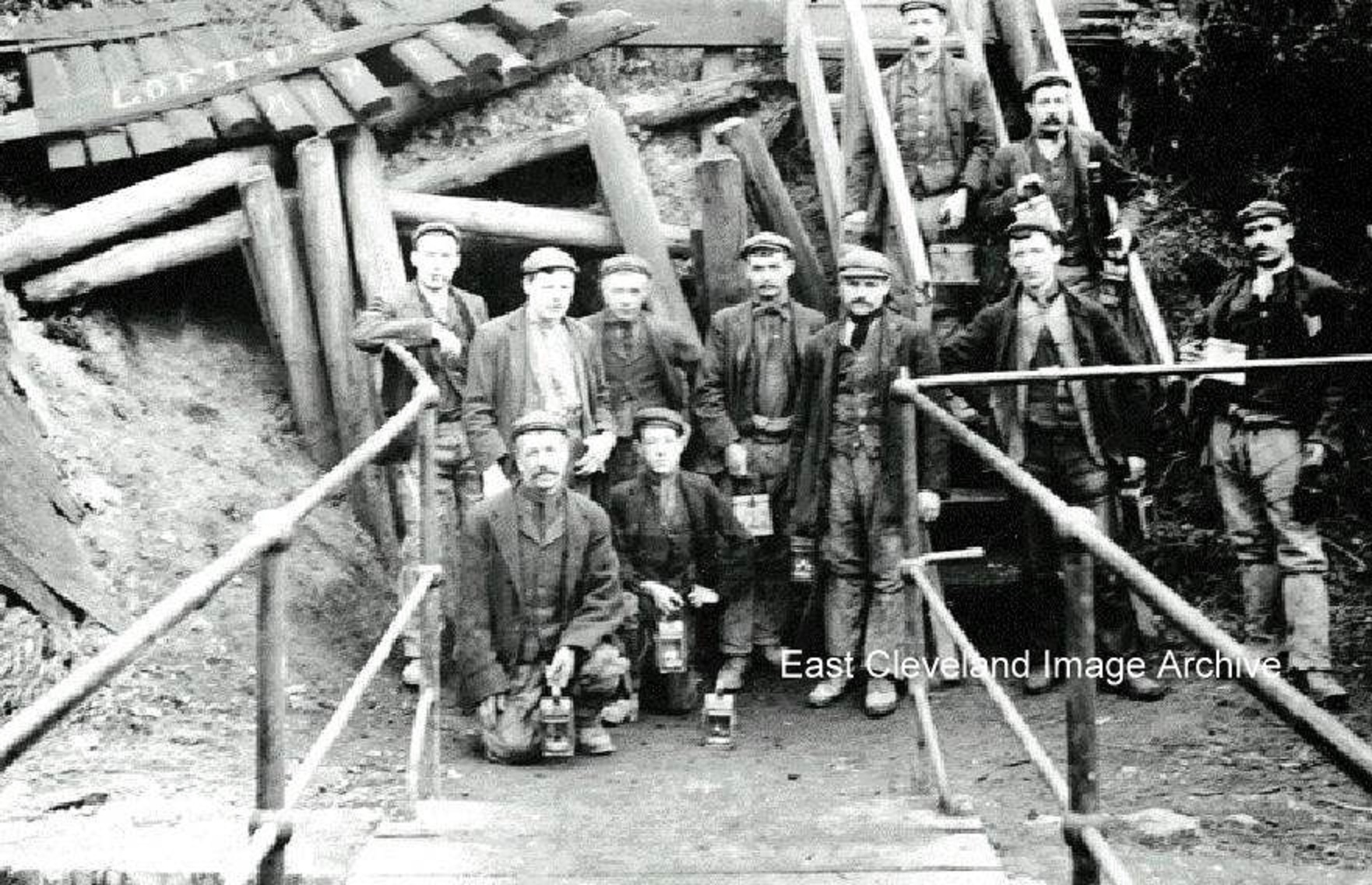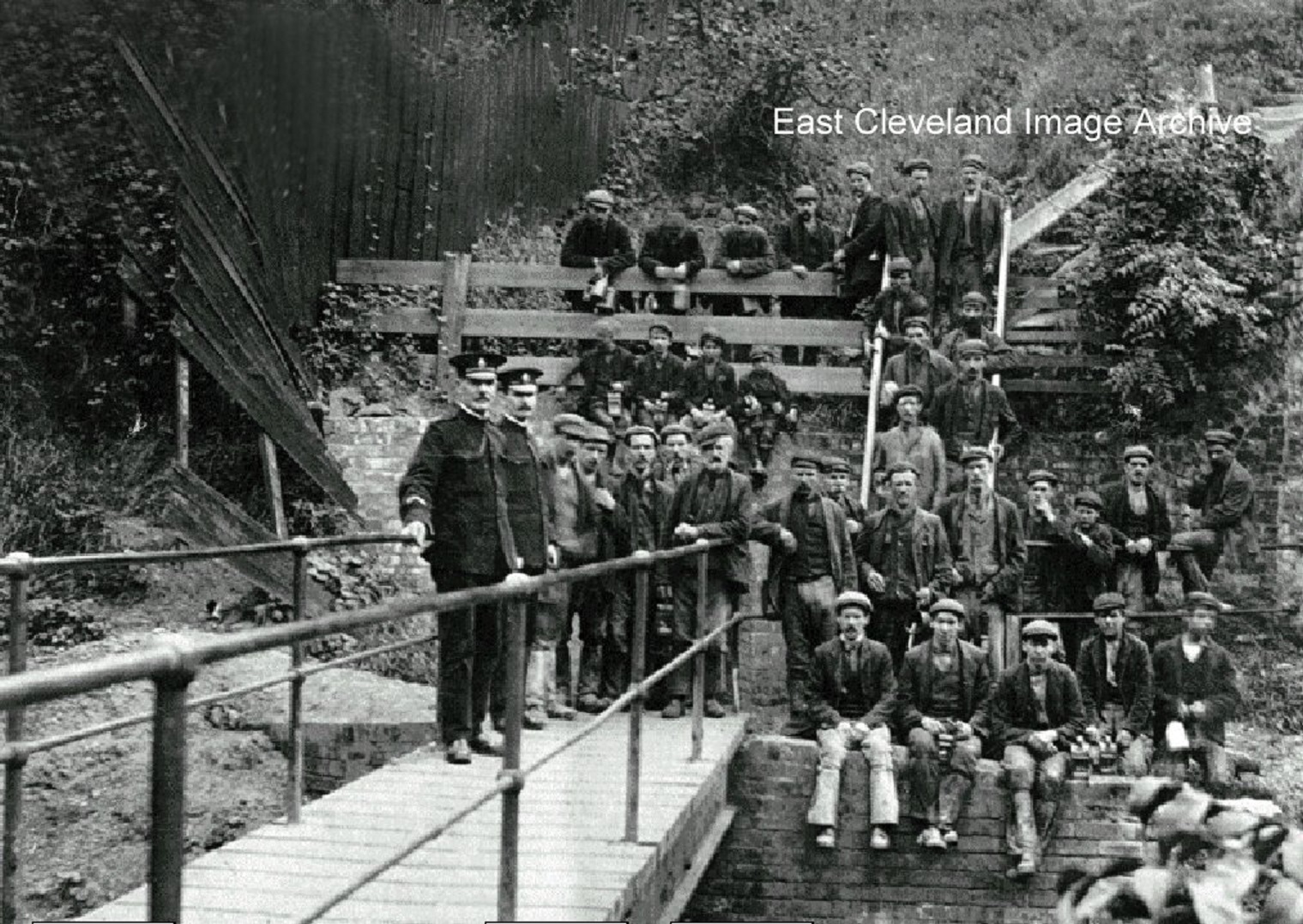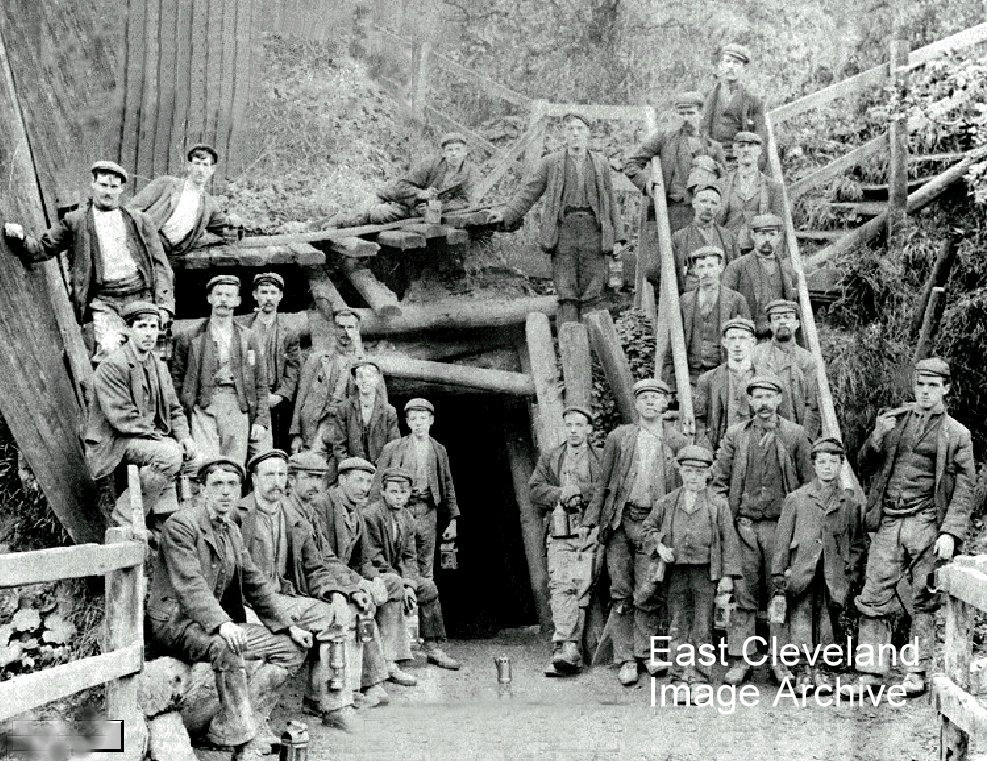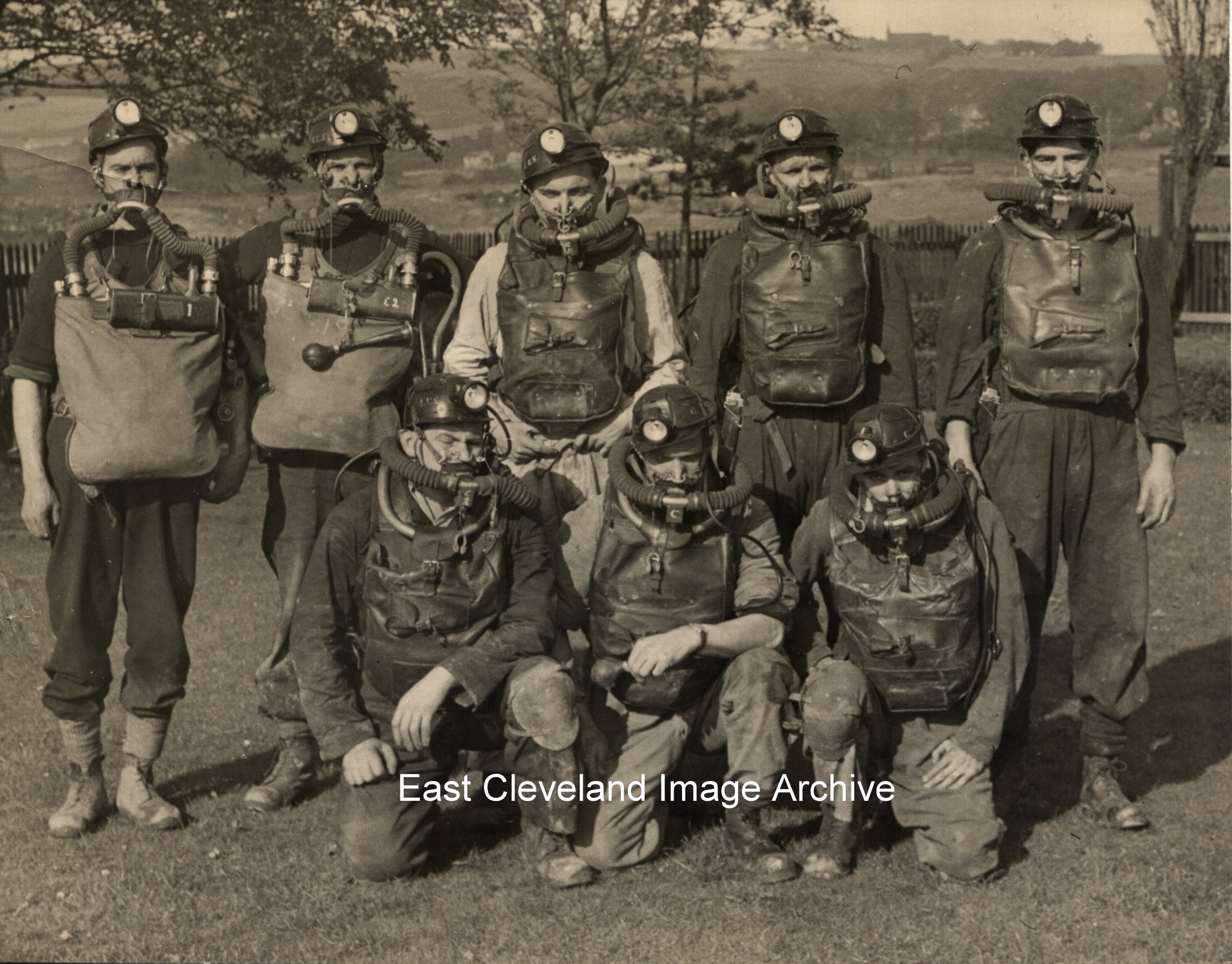
Another group of Loftus miners prepare to go in-bye. The photographer must have had a busy day! Can anybody identify any of the miners?
Image courtesy of the David Linton and Pem Holliday Collections.
|
|
||
 Another group of Loftus miners prepare to go in-bye. The photographer must have had a busy day! Can anybody identify any of the miners? Image courtesy of the David Linton and Pem Holliday Collections.  This is a similar shot to the other image of the Loftus Drift, but taken from farther back. Why the two police officers were present we didn’t know. Sheila Harris suggested: “My guess is that this is a strike. It is unlikely that so many men would be free to pose in any other circumstances. The police would be there to protect the owner’s interests.” However, David Richardson advises: “Outside what was the original main drift into Loftus mine which later became a traveling way when the North drift was opened further up the valley. There are 34 Mine Workers and 2 policemen visible in the photograph and while it is unusual that the police men are with them (maybe because of a strike as has been already mentioned) I have seen at least six different group photographs taken outside this drift so it wasn’t to uncommon an occurrence. In one of these other photographs the group totalled 41.” Perhaps their comments, are the definitive reason for the police being present. Image courtesy of the David Linton and Pem Holliday Collections, thanks also to Sheila Harris and David Richardson for their updates.  There’s an almost surreal look to this image – I’m having a job deciding whether it’s the real thing or an elaborate photographic studio set piece! This must be the travelling drift, because there’s no sign of any rails for tubs to run on. It looks like a full shift, right down to the trapper lads. It can’t be too early on because there are Davey Safety Lamps in view, although no safety helmets. Shot Cannisters are in evidence, but no picks. Can anyone name any of these men? Image courtesy of Cleveland Ironstone Mining Museum.  Not from outer space but from underground, we did not really know anything about this photo other than what was written on it: ”Crook rescue Team, Kilton Pit men. Dennis Pearson 1st Back”. Taken from the ’Evening Gazette’ Monday 3 May 1954: “Fourteen taken to hospital”. ‘Rescuers overcome in bid to save others. One Dead, 31 Gassed in Cleveland Mine’ One man was killed and 31 others were overcome by gas following an explosion at Kilton Ironstone mine, near Brotton today. The dead man was, Raymond Johnson age 40, loader man of 34 Gladstone Street, Loftus, whose body was brought to the surface about five hours after the explosion took place. Of the 31 overcome by gas were several of the rescue men; fourteen men were taken to hospitals in Redcar, Brotton and Guisborough, and the others treated on the spot. Helping the local mine rescue team were teams from Crook (two) Houghton le Spring and Benwell Tower, near Newcastle. Ambulances were sent from Redcar and Carlin Howe ‘Fire brigades help’ Middlesbrough Fire brigade and neighbouring fire authorities were asked to send resuscitation apparatus to the mine. It is believed that the explosion which displaced arches and roof supports occurred just before a three-man loader team started operations. The force of the blast blew Stanley Burton age 38 of 34 St Helens Walk, Liverton Mines and Iwan Dumoncie age 29 of 28 Tyne Street, East Loftus off their feet and threw them some distance. Burton suffering from cuts and abrasions was taken to the Guisborough Admiral Hospital, but the other man was allowed to go home.” It is worth visiting the Durham Mining Museum Site to read the full Mines Inspectors Report on this incident. Derick Pearson explained: ”This photograph was taken to show those associated with the clipping underneath it, and also because it was one of the rescue groups which covered many of the pits throughout the area including the coalfields. My father (Deputy) Dennis Pearson is first left standing on the back row. Next to him is Bob walker who lived at North Skelton at that time. The rest of the team I am certain were from different pits and on this occasion there were teams from 3 other pits. When I say team I mean 2 men teams in this instance. There were teams from Crook, Houghton le Springs and Benwell as well as others to drop back on in the event of a multiple disaster. The reason it was called Crook rescue team was because the rescue teams involved all travelled and practised their rescue methods at the mine at Crook. As my Father and Bob were from Kilton Pit the photo always got called “The Crook Rescue Team” by the local lads, hence the name on the back of it. Andrew Turnbull the Mine manager at Kilton Mine used to take my Father and Bob up to Crook in his vehicle, a Vauxhall Wyvern or Velox at that time. The Gas explosion rescue mentioned above was already in force before the rescue teams from the outlying Durham pits arrived and men like Rob Johnson and Bill Garbutt acted fearlessly trying to get their own mates out before the other teams came. The man who was killed was Raymond Johnson and was nicknamed ‘Chock Johnson’.” Many thanks to Derick for that explanation. Alan Featonby adds: ” I was at school with Andrew Turnbull’s son during the early 1960’s. At that time his father drove a Vauxhall Cresta ‘E’. It had the sun visor option and two tone paint, Gold and blue. Very stylish! My father had a 1955 Vauxhall Wyvern in gold, hence my recognition.” Image courtesy of Carlin How Community Centre and from a collection compiled by Derick Pearson in 1983, additional information courtesy of Eric Johnson.
Pictured we have two of the ironstone miners undertaking a record-breaking venture of removing ironstone in a one week period: on the left is Dennis Pearson, with on the right George (Ducks) Hollingworth at Kilton B . This photograph was taken for the record breaking venture that took place in Kilton Pit in the early 1950s. One week of absolute dedication; to drill, shot fire, fill tubs and lead the stone.
This is a view of the Calcining Kilns at Liverton Mines – which were well-known as being associated with the Ironstone Mine – these Kilns obviously dominated the landscape. Simon Chapman advises: “Railway wagons at this time were generally wooden bodies but couldn’t be used for carrying hot calcined ore which is why the N.E.R. built a fleet of steel wagons specifically for this traffic; a few can be seen to the left. In front are more steel wagons, built about 1906 to hold a greater tonnage”. Russ Pigott asked ”Were the larger steel wagons in the picture fitted with vacuum brakes? There seems to be a vac cylinder mounted above the sole bar on the end of the wagon. This would seem a bit strange as not many locomotives used on these trains were fitted for vacuum at the time”. Answered for us by Simon Chapman: ” Well spotted, Russ! Apparently they were actually fitted with air brakes and run as block trains from Liverton to Cargo Fleet works. This was such an unusual working that I can remember the late Ken Hoole trying to find out more information over 30 years ago. Note the large drum shape above each axle box on these larger wagons – some form of friction reducing roller which can’t have been very successful otherwise it would have become more common.” Russ said ”I thought the drum shape was the operating wheel for the hopper doors. What locomotives were used on these trains, I think most J21s were Westinghouse fitted but the J26s and 27s had no train brakes. That poor remaining J21 sits a mere couple of miles from me looking ever more like a Barry engine!” Thanks to Russ Pigott for the updates and many thanks to Simon Chapman whose information is invaluable to all who visit the site; Simon also thought it was: “A very atmospheric picture!”.
Here’s a group of miners and a pit pony (note to describe as a pony is a wrong description!) comprising the last shift coming out-bye at the Trustee Drift, Eston Mine, 18th September 1949. The mine had worked its 99 year lease, to the day. You can see the pulleys, rollers and cables of the main and tail haulage system for moving the setts around.
An ‘at work’ view of a group of miners – the lighting is obviously from magnesium flash placed at ground level. Now known to be a postcard dated 1910 and sent from Micklow Terrace in Loftus. It is a view of the ‘Deputies Cabin’ at Loftus Mine; Deputies were in charge of a District (specific mining area of an ironstone mine). Notice the conventional midge on the left and the Davy safety lamp of the Deputy on the right (holding the roof probe); also the rack of drill bits leaning against the wall on the left. Can anybody provide names?
A lovely clear photograph of Kilton Pit in full production by the look of the emissions from the chimney. Image courtesy of the Pem Holliday Collection.
The write up under the Huntrodd’s postcard view of Kilton pit included information that it was 680 feet deep and also was querying the windmill in the background possibly being used to pump water from the mine. Derick Pearson advised: “The shaft with the windmill at the back of this photograph, was an air return shaft as well as a second rout out in the event of problems. The windmill may have been used at that time to drive an output fan to draw the stale air from the workings which would in turn draw clean air in from the other shaft.” Image courtesy of the Pem Holliday Collection, thanks to Derick Pearson for the update. |
||
Recent Comments